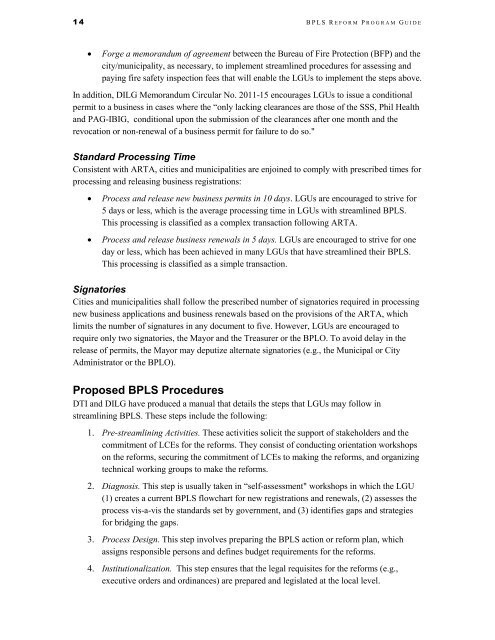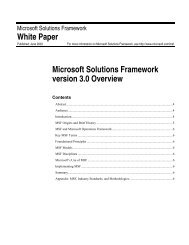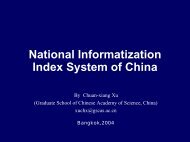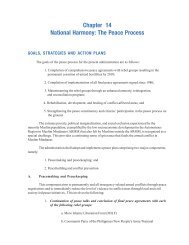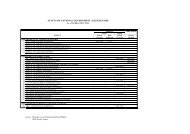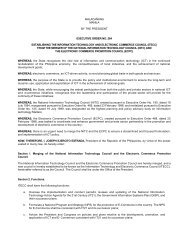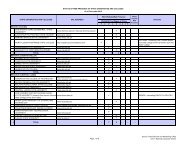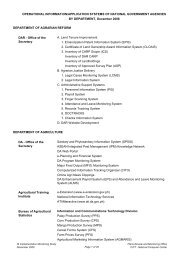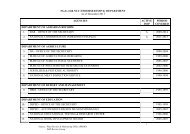BPLS Reform Program Guide - National Computer Center
BPLS Reform Program Guide - National Computer Center
BPLS Reform Program Guide - National Computer Center
You also want an ePaper? Increase the reach of your titles
YUMPU automatically turns print PDFs into web optimized ePapers that Google loves.
14 <strong>BPLS</strong> R EFORM P ROGRAM G UIDE<br />
• Forge a memorandum of agreement between the Bureau of Fire Protection (BFP) and the<br />
city/municipality, as necessary, to implement streamlined procedures for assessing and<br />
paying fire safety inspection fees that will enable the LGUs to implement the steps above.<br />
In addition, DILG Memorandum Circular No. 2011-15 encourages LGUs to issue a conditional<br />
permit to a business in cases where the “only lacking clearances are those of the SSS, Phil Health<br />
and PAG-IBIG, conditional upon the submission of the clearances after one month and the<br />
revocation or non-renewal of a business permit for failure to do so."<br />
Standard Processing Time<br />
Consistent with ARTA, cities and municipalities are enjoined to comply with prescribed times for<br />
processing and releasing business registrations:<br />
• Process and release new business permits in 10 days. LGUs are encouraged to strive for<br />
5 days or less, which is the average processing time in LGUs with streamlined <strong>BPLS</strong>.<br />
This processing is classified as a complex transaction following ARTA.<br />
• Process and release business renewals in 5 days. LGUs are encouraged to strive for one<br />
day or less, which has been achieved in many LGUs that have streamlined their <strong>BPLS</strong>.<br />
This processing is classified as a simple transaction.<br />
Signatories<br />
Cities and municipalities shall follow the prescribed number of signatories required in processing<br />
new business applications and business renewals based on the provisions of the ARTA, which<br />
limits the number of signatures in any document to five. However, LGUs are encouraged to<br />
require only two signatories, the Mayor and the Treasurer or the BPLO. To avoid delay in the<br />
release of permits, the Mayor may deputize alternate signatories (e.g., the Municipal or City<br />
Administrator or the BPLO).<br />
Proposed <strong>BPLS</strong> Procedures<br />
DTI and DILG have produced a manual that details the steps that LGUs may follow in<br />
streamlining <strong>BPLS</strong>. These steps include the following:<br />
1. Pre-streamlining Activities. These activities solicit the support of stakeholders and the<br />
commitment of LCEs for the reforms. They consist of conducting orientation workshops<br />
on the reforms, securing the commitment of LCEs to making the reforms, and organizing<br />
technical working groups to make the reforms.<br />
2. Diagnosis. This step is usually taken in “self-assessment" workshops in which the LGU<br />
(1) creates a current <strong>BPLS</strong> flowchart for new registrations and renewals, (2) assesses the<br />
process vis-a-vis the standards set by government, and (3) identifies gaps and strategies<br />
for bridging the gaps.<br />
3. Process Design. This step involves preparing the <strong>BPLS</strong> action or reform plan, which<br />
assigns responsible persons and defines budget requirements for the reforms.<br />
4. Institutionalization. This step ensures that the legal requisites for the reforms (e.g.,<br />
executive orders and ordinances) are prepared and legislated at the local level.


